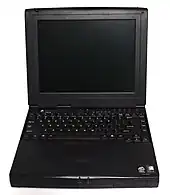 | |
 Solo 2200 | |
| Developer |
|
|---|---|
| Manufacturer | Sanyo (early models) |
| Type | Laptop |
| Release date | September 1995 |
| Lifespan | 1995–2003 |
| Discontinued | 2003 |
| CPU | |
The Solo was a line of laptop computers sold by Gateway, Inc. (originally Gateway 2000), from 1995 to 2003. All models in the range were equipped with Intel x86 processors and came preinstalled with the Windows operating system.
History

Gateway unveiled the Solo line of laptops on August 15, 1995, shortly before Microsoft's Windows 95 operating system became generally available for sale on August 24, 1995.[1] Initial entries in the Solo lineup were manufactured on an OEM basis by the Japanese company Sanyo.[2] The Solo was the first laptop to have a Windows key and a Menu key, which respectively activate the Start menu and context menus in Windows (the Start menu first appeared in Windows 95).[3] Gateway worked closely with Microsoft on development of the Solo to make it fully optimized with Windows 95, which was a nearly top-down redesign of Microsoft's previous Windows 3.1x operating systems.[4] The Solo replaced Gateway's earlier ColorBook and Liberty line of laptops and were the first of the company's laptops to feature Intel's x86-based Pentium processor, for which Windows 95 was optimized during its development.[1][5]
The Solo was released to retailers and corporate resellers in September 1995. The first two models—the V75 and the S90—came with Pentium processors clocked at 75 MHz and 90 MHz respectively.[6] Both Solos were multimedia-oriented and came with a Sound Blaster–compatible sound chip and removable CD-ROM drives bays as standard;[4] Gateway later made the CD-ROM drives an optional add-on to reduce cost at the entry level.[6] The company marketed the Solo at the cost-conscious businessperson and positioned it as a budget version of the more upscale IBM ThinkPad and Toshiba Satellite lines of laptops.[2]
Later entries in the Solo line featured the Pentium II, Pentium IIIs, and various P6-based Celerons.[7][8][9][10] The Solo line was retired in late 2002, Gateway still selling refurbished units on their website until 2003.[11][12]
References
- 1 2 "Gateway Intros Pentium Notebook PC". Newsbytes. The Washington Post Company. August 15, 1995 – via Gale.
- 1 2 Grevstad, Eric (January 1996). "A high-class, high-speed showpiece". Computer Shopper. SX2 Media Labs. 16 (1): 398 – via Gale.
- ↑ DiCarlo, Lisa (August 14, 1995). "Gateway aims to fly solo; high-end line optimized for Win 95, comes with extra cache". PC Week. Ziff-Davis. 12 (32): 6 – via Gale.
- 1 2 "New notebooks: Gateway 2000 announces Solo Pentium multimedia notebook". EDGE. EDGE Publishing. 6 (274): 22. August 21, 1995 – via Gale.
- ↑ Brown, Bruce (January 1996). "Gateway 2000". Computer Shopper. SX2 Media Labs. 16 (1): 167 – via Gale.
- 1 2 DiCarlo, Lisa (October 2, 1995). "Gateway gears up Comdex laptops; DEC hits snags". PC Week. Ziff-Davis. 12 (39): 1 – via Gale.
- ↑ Levy, Doug (April 9, 1998). "Pentium II chips zing up notebooks". USA Today. Gannett Company: 4B – via ProQuest.
- ↑ Burns, Simon (September 28, 2000). "Small is beautiful". Far Eastern Economic Review. Dow Jones & Company. 163 (39): 42 – via ProQuest.
- ↑ "Solo notebook out on its own". The Advertiser. News Limited: 90. March 31, 2001 – via ProQuest.
- ↑ Porterfield, Deborah (April 15, 2002). "New Products". USA Today. Gannett Company: 1 – via ProQuest.
- ↑ "Gateway Notebooks Series". Gateway.com. Gateway, Inc. Archived from the original on October 2, 2002. Compare with next available archived snapshot.
- ↑ "Gateway Remanufactured Notebooks". Gateway.com. Gateway, Inc. Archived from the original on April 2, 2003. Compare with next available archived snapshot.
